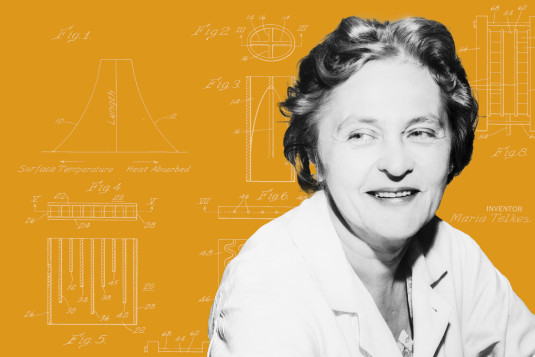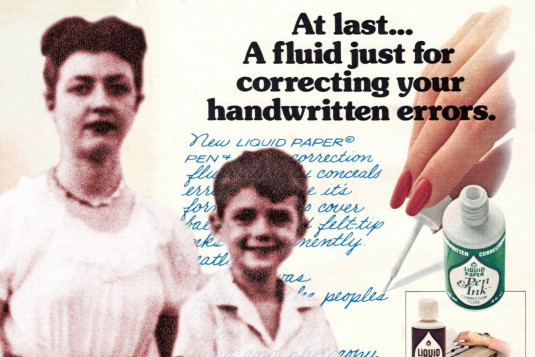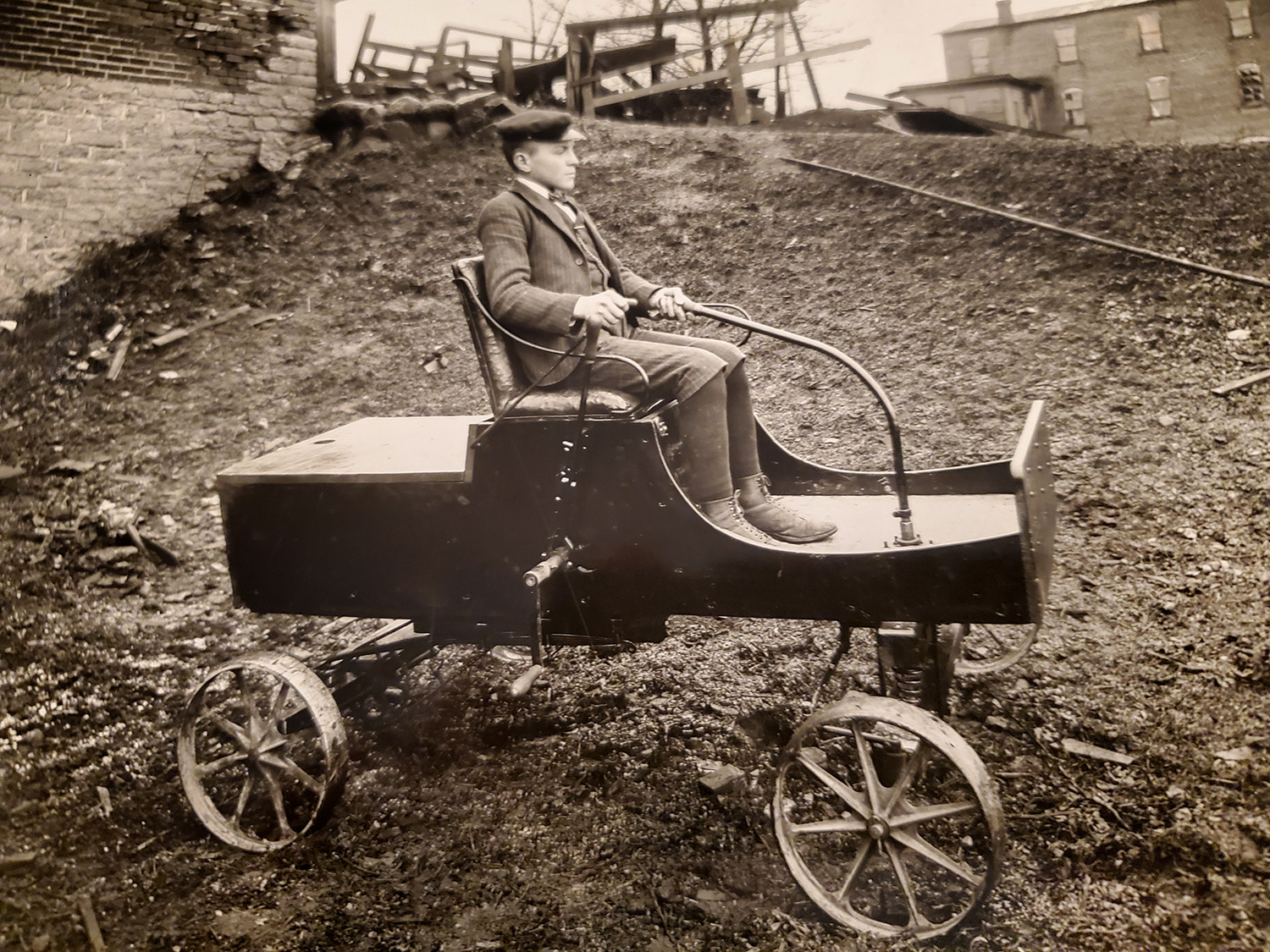
A brilliant touch
Blinded as the result of a childhood accident, Ralph Teetor learned to hone and use his other senses to invent, become a successful businessman, and participate in everyday activities — all with the determination to lead an independent, ordinary life.
19 min read
Each month, our Journeys of Innovation series tells the stories of inventors or entrepreneurs who have made a positive difference in the world. This month, Matt Graham's story focuses on Ralph Teetor, a blind inventor who used his exceptional sense of touch to create cruise control and other innovations that transformed the automotive industry. To learn about other historical inventors, check out innovators of the past.
Do you know an innovator or entrepreneur with an interesting story?
Under the pale light of the moon they worked, racing from one end of the machine to the other, tightening bolts, checking belt tensions, and configuring wheel alignment, kicking up clouds of dust with each excited footstep.
One 12-year-old boy sprints to the family’s workshop to retrieve a tool while the other young lad adds fuel in preparation for the 1-cylinder automobile’s maiden voyage. The cousins, both preteens, had worked nonstop on their creation, using spare parts from the family business and machining each component by hand to build the vehicle from scratch.
With the roads clear of horse and buggy traffic at this early hour, it was now or never.
One boy sits in the driver’s seat while the other grips the hand crank. White knuckled, the young engineer uses every muscle in his arm and chest to throw the lever into motion, one rotation and then another and another until the engine sputters to life and the machine lurches forward.
Success.
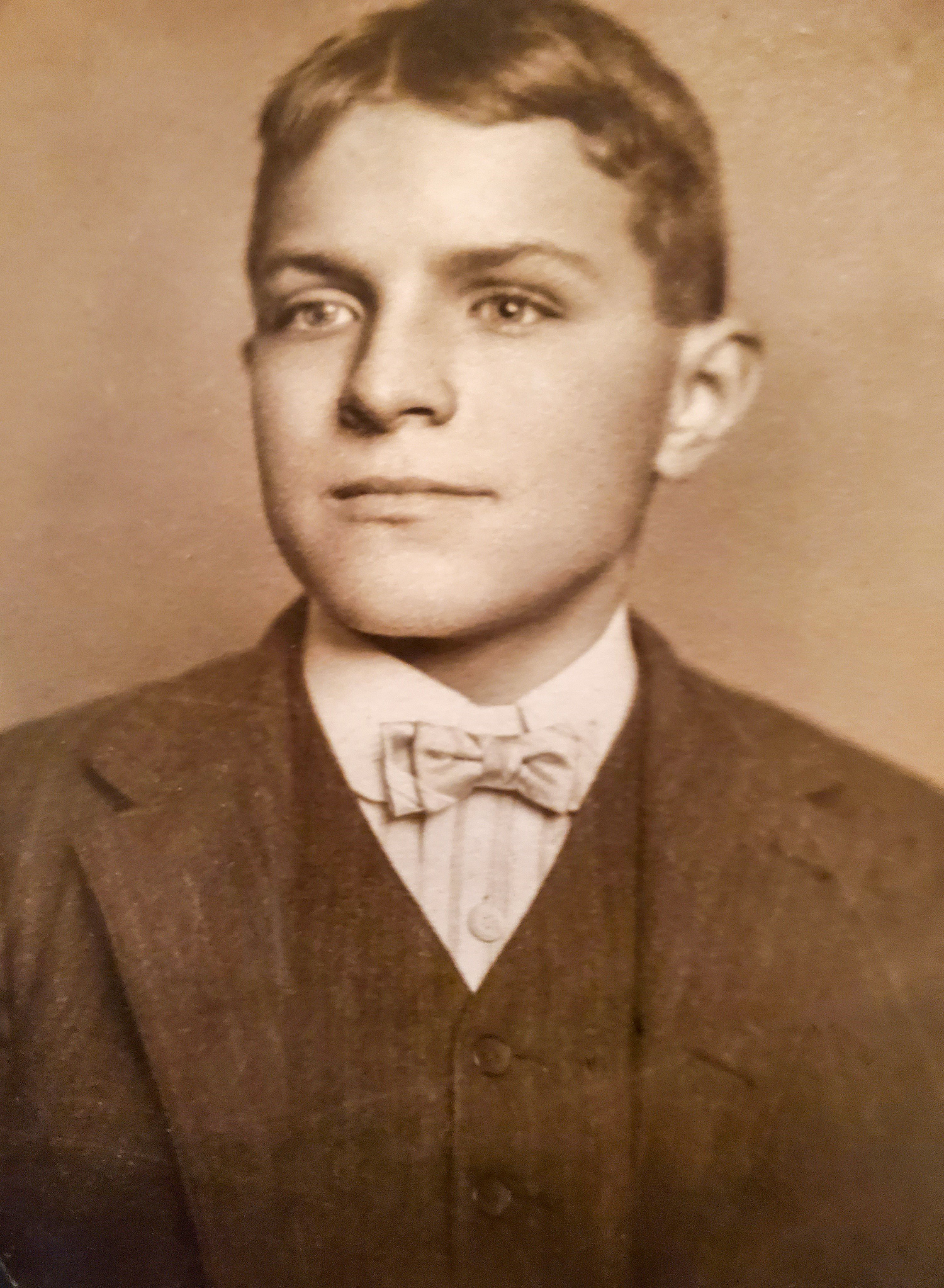
Ralph R. Teetor was blinded at age 5 and despite the challenges faced, grew up to become one of the most influential automobile engineers in American history.
(Photo courtesy of Jack Teetor)
The cousins’ contraption reached 12 miles per hour, an amazing feat for kids of any age or ability, but it was especially impressive given that one of the young engineers was blind.
Ralph Teetor wasn’t born blind; his disability was the result of a childhood tragedy on March 20, 1896. According to The Hagerstown Exponent, the then 5-year-old was playing with a knife and somehow ended up injuring his right eye badly enough to lose sight in it permanently.
Over a period of about two years, the young man was plagued with what is known as sympathetic ophthalmia, which resulted in slowly weakening vision before he ultimately lost sight in his other eye.
Ralph treated this tragedy, which could have been profoundly debilitating, as a challenge to overcome. And throughout his life, his experience with blindness gave him perspectives on problem-solving that led to not only exemplary work, but a world-changing technology.
The ability to be self-reliant and overcome adversity were two characteristics that were instilled in him by his parents, who insisted that he be treated like any other person, said Jack Teetor, his grandnephew.
“In raising him to believe that he was not handicapped, in a sense, I'm thinking that maybe it forced him to use his other senses, and develop his other senses,” he said.
Ralph would hone and use his other senses, particularly his audio and tactile senses, to invent, become a successful businessman, and participate in everyday activities — all with the determination to lead an independent, ordinary life.
This resolve was exemplified in the summer of 1945, when he addressed a group of returning wounded World War II veterans who were also blind.
“Nothing can stop you from enjoying a normal happy life once you have made up your mind that is what you are going to have,” he told the gathering of 200.
While Ralph enjoyed many common milestones — he attended school, got married, had a family — in truth, his life and career was exceptional.
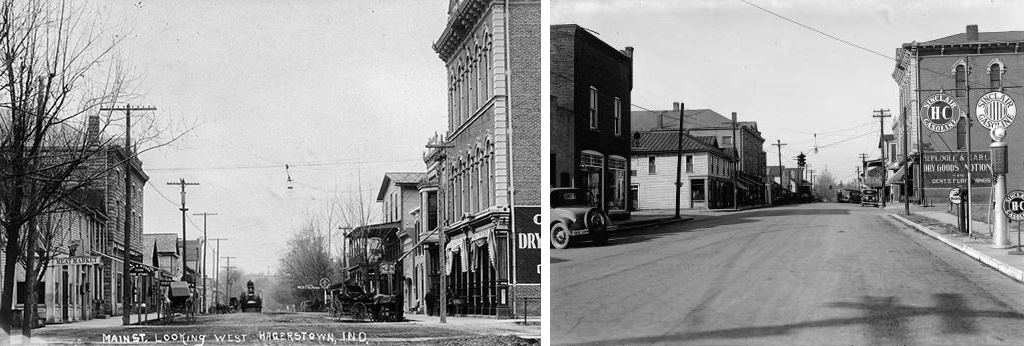
The development of the internal combustion engine and the harnessing of electricity during the early 20th century allowed communities like Hagerstown, Indiana, to transition from horse and buggy transportation to automobiles as seen in these two photos of Main Street taken in 1909 and 1920.
(Photo on left courtesy of Indiana Album: Harley Sheets Collection. Photo on right courtesy of the Indiana Historical Society)
Born August 17, 1890, Ralph R. Teetor was a part of the large Teetor family that eventually settled in Hagerstown, Indiana after immigrating from Germany in 1729. The family as a whole was known for being mechanically inclined — they are collectively named on nearly 200 patents — and ardent workers, spanning multiple generations. The shop where the boys worked on their automobile was normally used in the day-to-day family business, the production of railway inspection cars. Initially powered manually by pedaling, the Teetors quickly transitioned to using technology that would not only transform their business but would change the American way of life.
At the heart of it all was Ralph, whose lifetime coincided perfectly with two major innovations: the internal combustion engine and electricity.
Building off of the success and knowledge gained from the development and use of the steam engine, tinkerers throughout the 1800s experimented with ways to encapsulate the burning of fuel to make the process more efficient. Multiple concepts were developed, and patents granted throughout the mid to late-1800s that focused on containing and directing the pressure of the expanding gasses and converting it into work to power a vehicle’s drive shaft. The result was the internal combustion engine, a game changer for society and a lifelong passion for the engineer.
The other major innovation that was making its way across the country was electricity — a fascinating concept to Ralph. At 12, he was considered to be the “youngest successful electrician in the world” according to a report from The Cincinnati Enquirer, often astounding other electricians by correctly answering every question that was thrown at him.
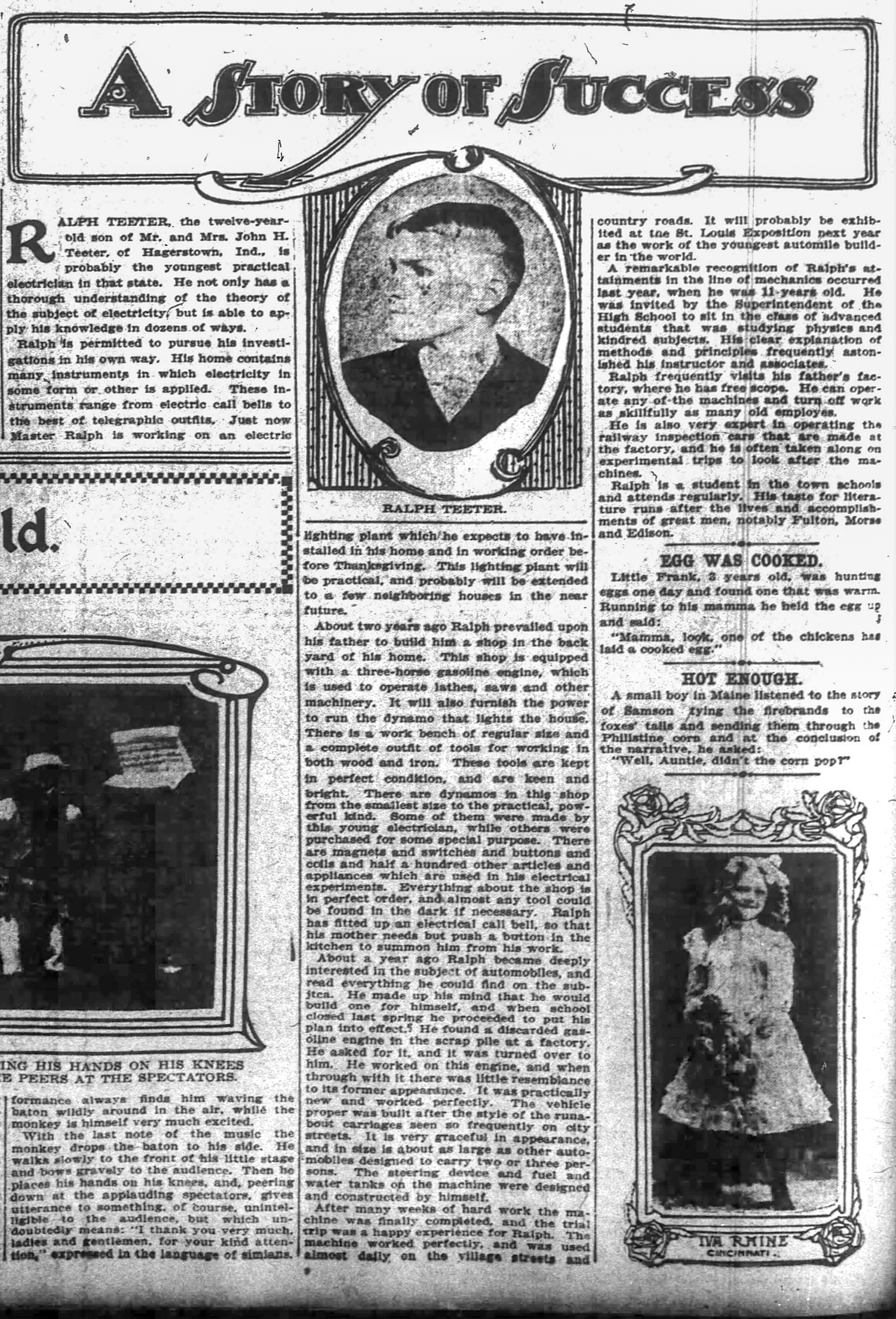
A cutout from the Cincinatti Enquirer shows a feature article about a young Ralph Teetor who displayed an impressive knowledge of electricity by the age of 12.
(Photo courtesy of Jack Teetor)
In 1908, by then living without sight for nearly a decade, Ralph was credited with providing Hagerstown with its first connection to electricity. He proposed to his high school graduating class to have the first electric sign in town, after already wiring his personal workshop with electricity, thanks to a generator built by his uncles in their factory. The class agreed and he went to his family’s workshop and began building the sign and wiring it to hold light bulbs that spelled out “1908.” The sign had wires that ran out the window and across the street to a building next door, connecting to a generator for its very first use. Ralph’s sign was a brilliant success.
The young electrician then built upon the signage success by taking on the family home.
“[He wired his] parents’ home much to the neighbor's surprise. Their house was the only one that was lit up,” said Jack. “That was really pretty amazing that he figured that out.”
Despite his intellect being well-known in the community, there was some doubt about his ability to pursue higher education. In addition to the challenges posed by his blindness, Ralph also did not have the proper prerequisites, a result of having attended a small high school. It took applying to a couple of different schools, and some heavy advocating by his cousin Neva, before the University of Pennsylvania allowed him to enroll as a “special student” in the fall of 1908.
“Society really didn't know how to treat people with disabilities or more specifically blind people,” at that time, Jack said. “So, he had to overcome such insurmountable odds at a young age.”
Once he began his academic work, it was evident that he was not only a capable student, but an exceptional one. At that time, the university had a policy that exempted the upper one-third of the class from finals, and Ralph did so well during his time in school that he never once sat for a final exam. But that’s not to say he didn’t face any obstacles. His cousins Dick Waltz and George Keagy lived with Ralph and would help him by reading his lessons to him. However, there was a graduation requirement to make a set of graphs and charts that he couldn't receive assistance for. Ralph created the graphs by using a screen wire with a similar layout to graph paper and different colored strings woven throughout the screen to mark the data. It was another example of the young engineer’s ingenuity and determination to solve the challenges life presented him.
In addition to his coursework, Ralph joined the Whitney Engineering Society where he became the mechanical editor of their periodical. Not only did he edit the paper, but he published two articles on the subjects of the use of the manograph indicator, a device used to measure high-speed engines, and the high-speed internal combustion engine.
Because of his successful completion of the engineering program, the University of Pennsylvania started admitting more blind students. The university allowing blind students to matriculate coincided with a nationwide movement of advocacy for the blind that emerged in the early 20th century. The American Association of Workers for the Blind, founded in 1905, helped standardize and regulate braille, increasing accessibility and opportunities for the visually impaired. This was followed by The Smith-Fess Act, which provided vocational assistance to civilians with disabilities when it became law in 1920.
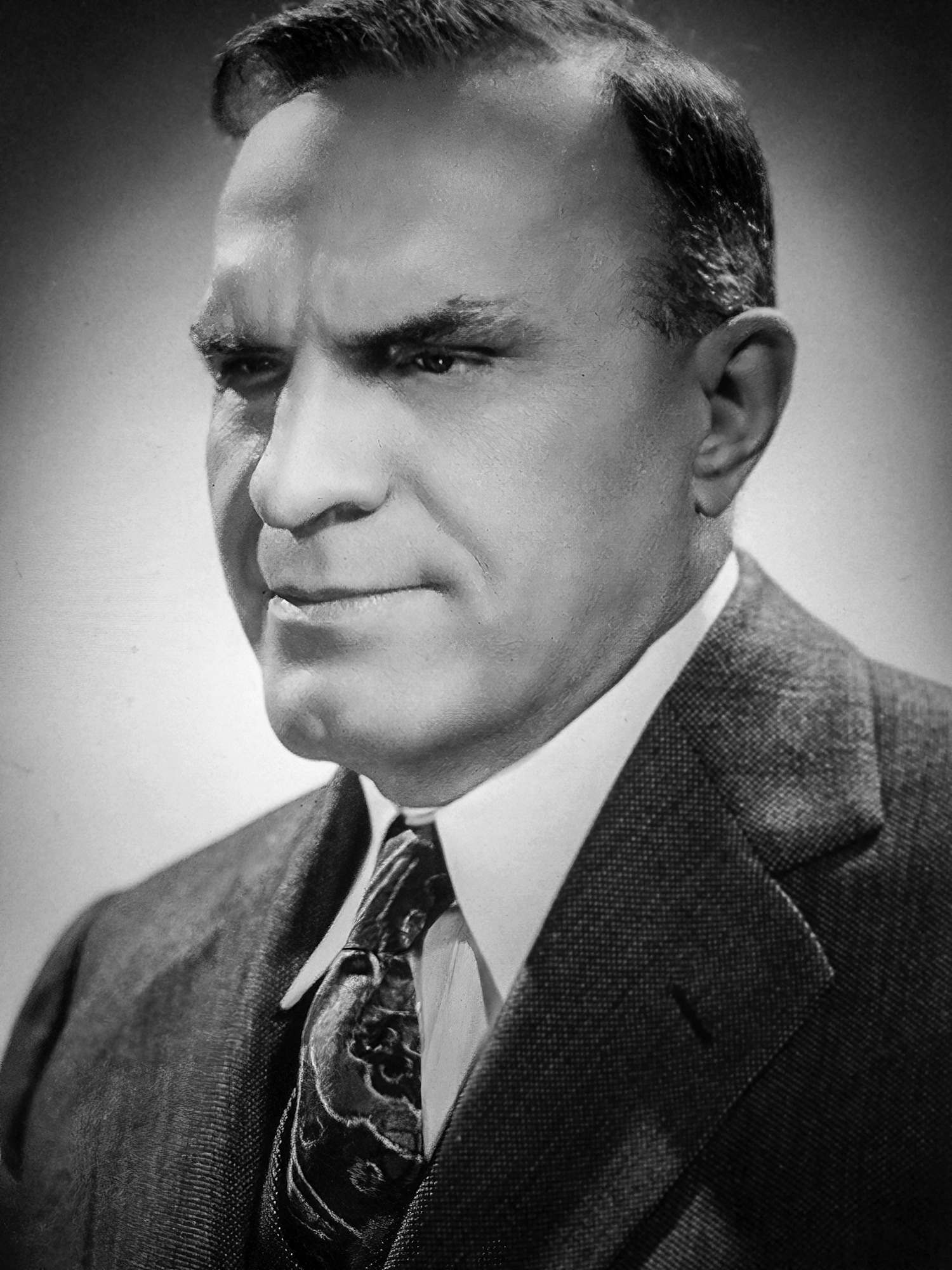
Ralph Teetor worked his whole life to improve the automobile, culminating with his invention of the Speedostat, which is more commonly known today as Cruise Control.
(Photo courtesy of Jack Teetor)
With a mechanical engineering degree in hand, Ralph returned to his hometown of Hagerstown in 1912 to take a role in the family business.
Founded in 1895 in a one-room shack, the Teetor clan made lightweight railway pedal cars — designed by Charles N. Teetor — for railroad workers such as track inspectors, lamp tenders, and linemen, originally under the name of the Railway Cycle Manufacturing Company. With the advent of the gasoline engine at the turn of the century, the company began to build and incorporate them into their products and eventually transitioned to automobile engines under the name Teetor-Hartley Motor Company in 1914.
Located an hour outside of Indianapolis — once considered a legitimate rival to Detroit’s car making prowess — the Teetor-Hartley Motor Company was well placed to provide engines and parts for cars, which were custom ordered and made at the time. Instead of purchasing parts from outside sources — a common practice then — the company machined nearly every part in their plant as a way to keep costs down and to align with their “don’t buy it, make it” business philosophy.
Early on, the Teetors recognized the importance of piston rings — a vital engine component that helps create the seal around the piston — to the overall performance of the engine, so special attention was paid to the company’s piston ring department. This fortuitous insight would propel the company to the top of the auto parts industry.
When Henry Ford’s assembly line method reduced demand for custom car orders and made Detroit the auto manufacturing king, the business pivoted from producing custom engines to focusing on the piston ring. At that time, piston rings needed to be replaced every 12-15,000 miles, meaning that the market need was strong both in manufacturing as well as repair shops.
“Ralph and his uncles, I think, recognized what was happening, [and] I think they read the market very well,” Jack said of the company’s transition.
With the focus now on piston rings, a new company called Perfect Circle was born in 1921.
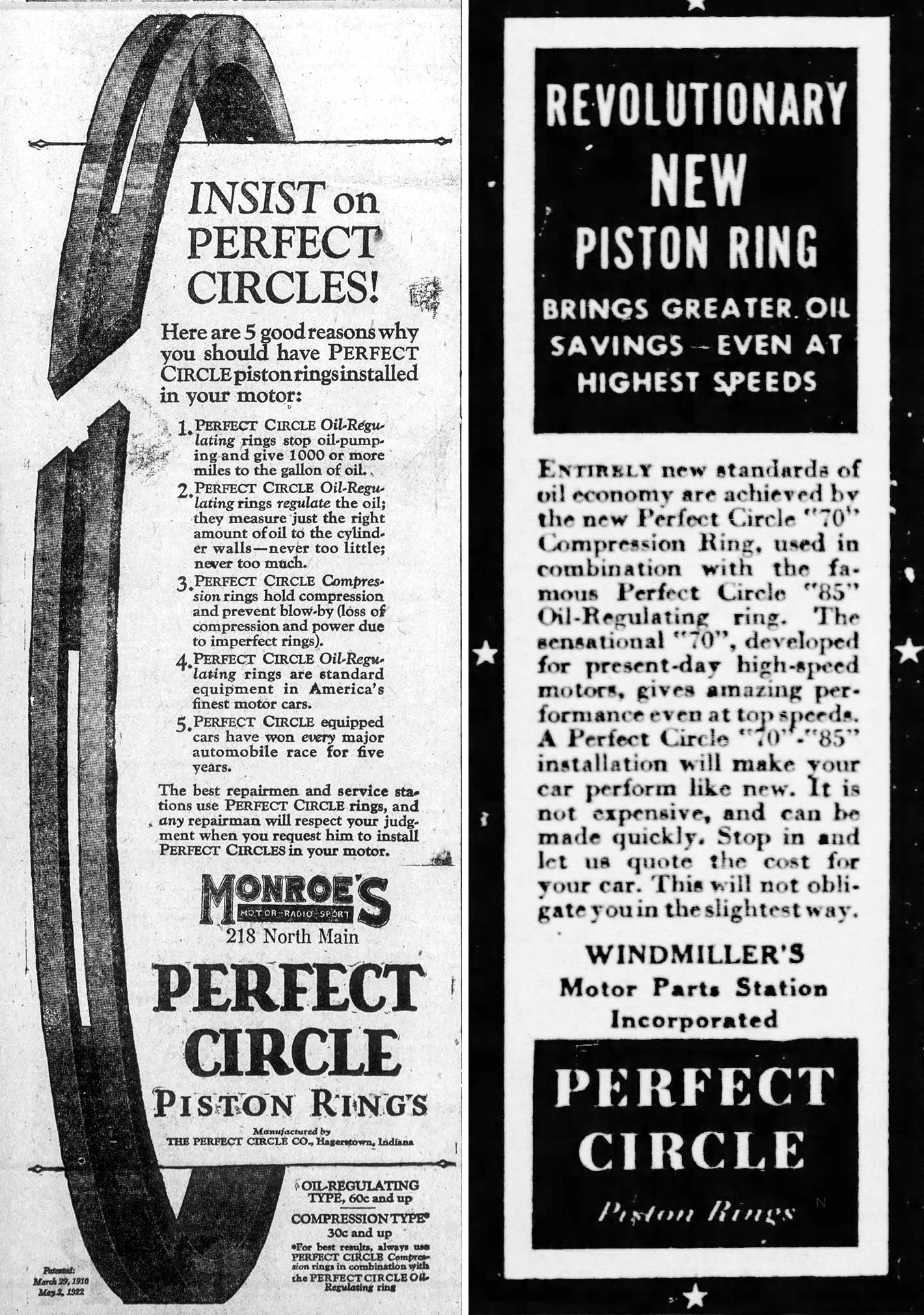
Many of the advancements outlined in these two advertisements for Perfect Circle piston rings were the result of Ralph Teetor’s engineering prowess for which he received numerous patents. On left, a 1927 ad from The Piqua Daily Call in Ohio. On right, a 1934 piston ring ad from the Fort Worth Star-Telegram.
(Newspapers.com)
The company quickly went to work improving the production of the piston ring and the product itself. In 1923, Ralph R. Teetor was granted a patent for a “tool for compressing piston rings” that helped close gaps that formed in the rings after they were cast. The inventive family patented additional tools related to piston ring manufacturing during the 1920s before turning their focus on the product itself.
In 1931, Ralph was awarded U.S. Patent No. 1,825,893 for “piston and piston ring.” The patent describes the invention as “an oil regulating ring having elongated drain slots widened at the exterior face of the ring” whose purpose was to “exert substantially uniform pressure against the cylinder wall throughout the circumference of the ring.”
In 1937 and 1938, he was awarded two patents — Patent No. 2,084,828 and No. 2,110,562 — for his piston ring expander innovations. The purpose of the expander was to “engage the ring and insure [sic] the desired pressure characteristics of the ring and proper contact between the ring and the cylinder bore.” The 1937 invention was noted to be “inexpensive to manufacture” as well as “highly efficient and durable in use.”
In all, Ralph and various members of the Teetor family patented nearly 50 innovations related to piston rings during the first half of the 20th century.
“It is not surprising to find practically every major improvement in piston ring design and performance [was] a Perfect Circle achievement,” stated a 1944 Palladium-Item news article which recounted the company’s history as it approached its 50th anniversary.
Although Ralph made a name for himself in the automotive industry with his piston ring innovations, his true passion was finding solutions to life’s everyday challenges.
An inventor at heart, Ralph was awarded multiple patents beyond his family’s company, from a fishing rod handle to a fluid actuated automatic gear shift. He even invented a new lawnmower when he couldn’t find one that would cut the grass in the way he specifically wanted it cut. However, his most famous invention was something he called the Speedostat. Today, we know it as cruise control.
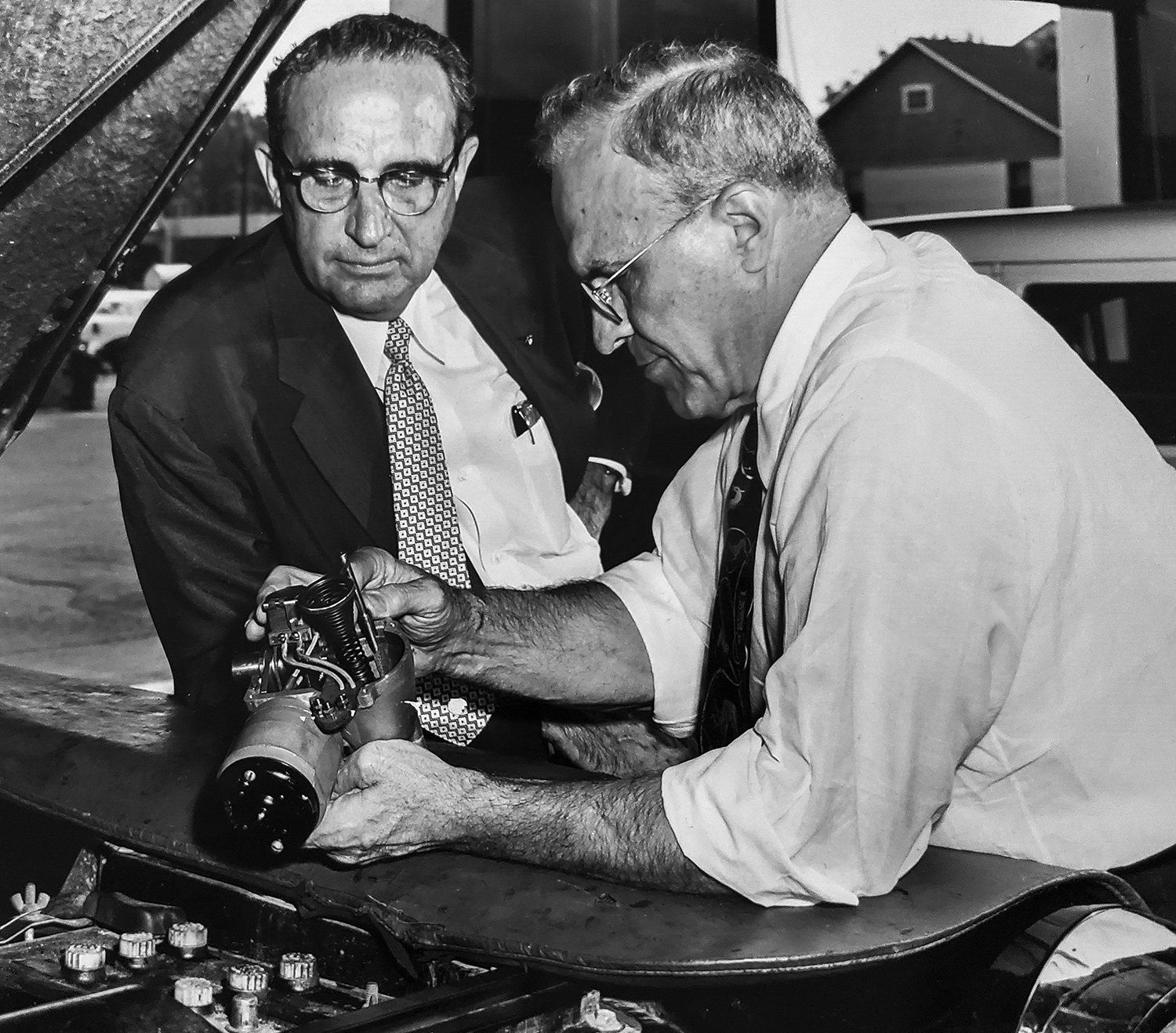
Ralph Teetor, holding the cruise control device he invented, shows the technology to Perfect Circle President William Prossner.
(Courtesy of Jack Teetor)
In the 1990s, Ralph's vision became a reality with the development of Adaptive Cruise Control (ACC). The technology uses sensors, radar, or cameras to monitor traffic conditions and adjust a vehicle's speed accordingly. This innovation both improved driving comfort and, more important, enhanced safety by reducing the risk of rear-end collisions.
How was a blind mechanical engineer able to imagine and patent so many inventions that required a high degree of accuracy?
Tactile touch, a skill Ralph honed throughout his life.
From the building of a 1-cylinder automobile as a young man and the decades of machining parts in-house during his nearly five-decade career at Perfect Circle, to enjoying everyday leisure activities, the ability to “see” through the use of his hands astounded onlookers.
This skill was on full display in 1918 when Ralph took a one-year hiatus from the family business to offer his services in an effort to help the war effort, as the United States had entered World War I the previous year.
He took a volunteer position as a mechanical advisor for New York Shipbuilding Corporation at their facility in Camden, New Jersey. Although he was given a desk in the office, Jack said company officials did not assign Ralph any work. Undeterred, he overheard discussions about a balancing issue concerning the turbine rotors in the engines for the Navy’s new torpedo boat destroyer. The imbalance caused the engines and propellers to break apart at high speeds.
Ralph, who had previously dynamically balanced crankshafts for race cars, approached the company with a solution, Jack said.
“They kind of laughed it off and said, oh... we know how to do it. And he kept arguing and fighting for the chance to try. And, so, they let him try,” he said.
Using his vibrotactile perception — or sense of vibration — Jack said Ralph was able to rotate the rotors and make incremental adjustments until the shaft was completely balanced — problem solved.

Despite being blind from the age of 5, Ralph Teetor never let his inability to see prevent him from doing the things he loved, including driving.
(Courtesy of Jack Teetor)
During his career at Perfect Circle, Ralph often used his sense of touch to accurately judge the size of mechanical components, one time declaring a piece too large by a couple thousandths of an inch. After some scrambling for a measuring instrument by peers, he was found to be correct.
This uncanny ability prompted some to quip that Ralph wasn’t really blind, it was just a joke he put on people.
His own daughter, Marjorie, didn’t know her father was blind until the age of 10.
Her nephew, Jack Teetor, recalled that his aunt told him of a time when, “a classmate [said to her] ‘well, your dad is blind.’ And she said, ‘no, no, no. Dad's not blind. He sometimes bumps into things, but he is not blind.’ She really didn't know that he was blind because he built her a steam engine. He taught her how to roller skate, how to ride a bike, how to read gauges.”
In addition to his tactile sense, Ralph used audio clues to create mental maps in order to navigate his surroundings.
Comfortable both walking and driving around town, Ralph would often use his memory coupled with his sense of hearing to judge where he was and where he needed to go. He walked himself to the barbershop downtown every day for a shave, all the way up until the mid-1940’s when paved roads and quieter cars made it harder to navigate by ear. Even on business trips to Detroit, Ralph could expertly recall the routes to his favorite steak house and ice cream shop.
When the inventor and businessman found himself with downtime, he could be found at the family lake house on Lake Wawasee enjoying time with his wife, Nellie, a schoolteacher he married in 1922, and his only child, daughter Marjorie.

A devoted family man, inventor Ralph Teetor enjoyed spending downtime with his large extended family on Lake Wawasee in Indiana. Pictured is Ralph Teetor, center, sitting next to his daughter, Marjorie, in the white blouse, wife Nellie, sitting across from the inventor, and Dorothy, another Teetor relative.
(Courtesy of Jack Teetor)
Generations of Teetors spanning multiple families would flock to the lake for summer vacation, spending time fishing and racing speedboats — two of Ralph’s favorite pastimes.
Ever the inventor, he developed and patented a fishing rod handle with an adjustable grip that could provide convenient casting and trolling positions. In one position, the handle was straight, like most fishing rods, but the handle could also be rotated into a pistol-grip like handle.
When Ralph wasn’t bobbing for fish, he and his family would be making waves on the surface.
Jack shared that his grandfather and Ralph both owned vacation homes on the lake as well as speedboats and could routinely be found crisscrossing the lake.
“[Lake] Wawasee was very important in his life because I think it was 1914 where he built his first speedboat,” he said.
Ralph loved speed boats, especially the boats being made by his personal friends, father and son Christopher and Jay Smith, from the famed Chris-Craft company. He customized his boat house so that it could hoist one boat into the air and park a second boat underneath it. Over time, he owned several different speed boats, but they all shared one thing in common — all of his boats were named “Siren”.
The prolific inventor’s passion for speed and engines naturally led him to one of Indiana’s star attractions — the famous Indianapolis “Indy” 500.
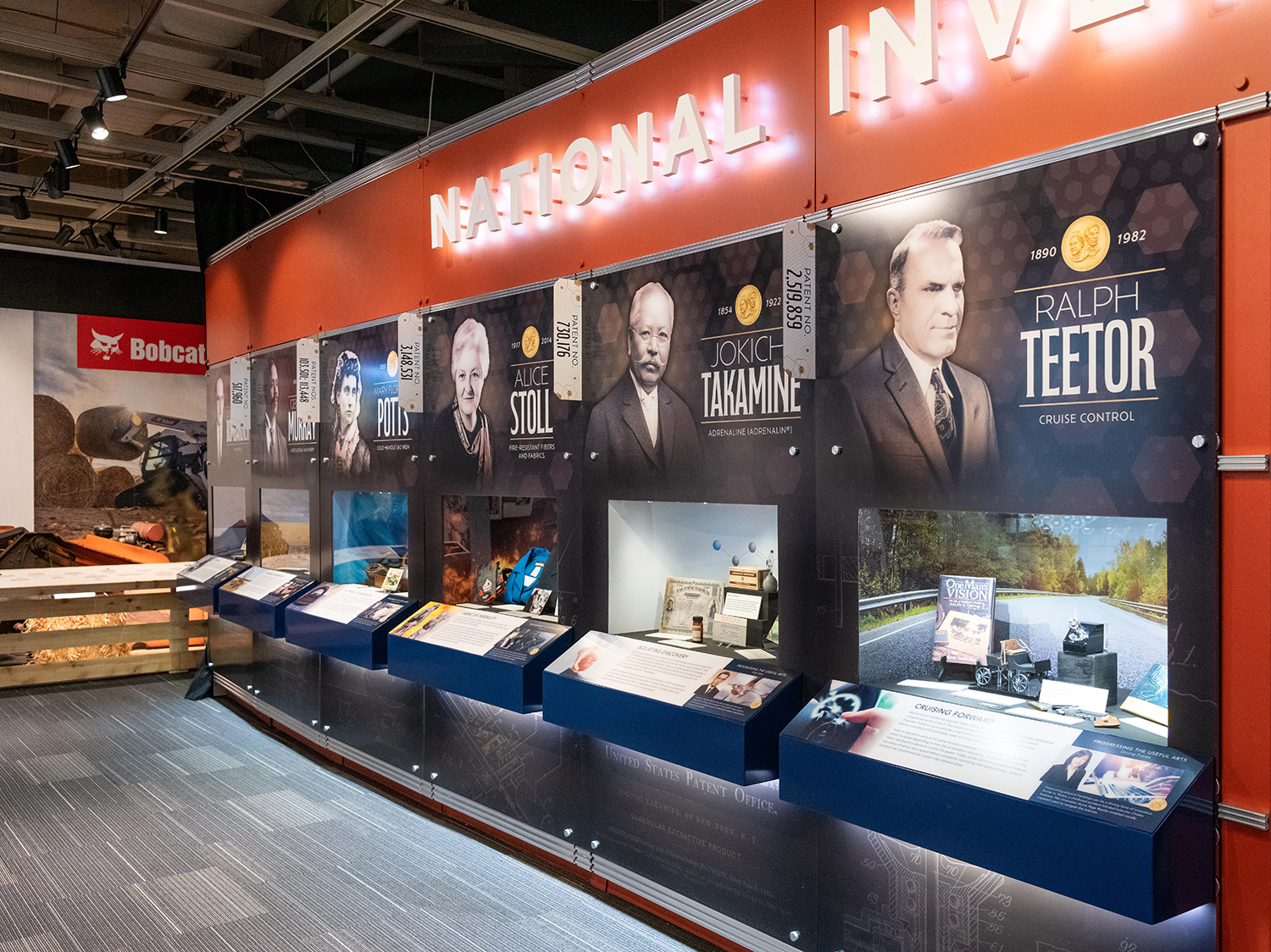
For his contributions to the automotive industry, Ralph Teetor was posthumously inducted into the National Inventors Hall of Fame in 2024.
(Courtesy of the National Inventors Hall of Fame)
The company’s success at the Indy 500, coupled with Ralph’s love of high-speed engines, made it easy for him to ingratiate himself with the speedway’s leadership. Despite being blind, he was selected as one of the race’s stewards for the 1937 race to settle any competition disputes.
In addition to his support on the racetrack, Ralph was also an active member of the community.
A huge proponent of education and youth activities, he served on Hagerstown’s board of education and donated a 28-acre parcel of land — later named Camp Wapi-Kamigi — to the Boy Scouts and Girl Scouts to provide the groups with a place to do Scouting activities like camping.
Ralph's work in automotive engineering, as well as his humanitarian efforts, earned him numerous accolades and honors. This included being named a member of the Indiana Academy in 1971, receiving the Hagerstown Rotary Club “Good Friend and Neighbor” award, the Scout’s Silver Beaver award in 1931, and the establishment of the Ralph R. Teetor Educational award in 1963 by the Society of Automotive Engineers, an organization he joined while still in college.

An illustration of Ralph Teetor surrounded by images related to his impressive career as an inventor and business owner. He was inducted into the Automotive Hall of Fame posthumously in 1988.
(Photo courtesy of Jack Teetor)
Home to major automobile manufacturers in the early 1900’s, it was only a matter of time before investors got together to build a track in Indianapolis where vehicles, and parts, could be put to the test. In 1909, construction for the Indianapolis Motor Speedway began. What started as a dusty dirt path was quickly paved with brick and then the race was extended to 500 miles, testing the various parts at both top speeds and over prolonged periods of time. The first car to win with Perfect Circle piston rings was in 1922, only one year after the company was stood up. From the very beginning, Perfect Circle rings were a common denominator among winners and front of the pack finishers. In fact, drivers who used Perfect Circle piston rings routinely asked Ralph to oversee the installation, knowing his approval meant the job was as close to "perfect" as could be.
The two highest honors for the prolific inventor and automotive engineering giant would come after his death at the age of 91 on February 15, 1982. Ralph was inducted into the Automotive Hall of Fame in 1988 and into the National Inventors Hall of Fame alongside 14 other inventors in 2024.
“That this many years after Ralph Teetor passed away, that he would be recognized for his cruise control... it was one of the most exciting experiences of our lives,” Jack Teetor said of Ralph’s induction into the National Inventor’s Hall of Fame and the family’s participation in the event. “It is almost like his life has now come full circle... it really warmed our hearts.”
Ralph’s journey from a blind child to a pioneering engineer is a testament to the power of determination and innovation. His invention of cruise control and his vision for adaptive cruise control have had a profound and lasting impact on the automotive industry. An inspiration to inventors and engineers worldwide, Ralph's legacy serves as a reminder that innovation knows no bounds, and even the most challenging circumstances can lead to groundbreaking discoveries that shape the world we live in.
Credits
Produced by the USPTO’s Office of the Chief Communications Officer. For feedback or questions, please contact OCCOfeedback@uspto.gov.
Story by Matt Graham. Additional contributions from Whitney Pandil-Eaton, Rebekah Oakes, and Julianne Simpson. The photo at the beginning of the story is courtesy of Jack Teetor and shows the actual vehicle built by the cousins. Special thanks to Jack Teetor and Ralph Meyer.
References
Ginther, Cash. “A Story of Success.” The Cincinnati Enquirer. November 19, 1902.
“Internal Combustion Engine Basics.” Department of Energy, November 22, 2013. https://www.energy.gov/eere/vehicles/articles/internal-combustion-engin….
Meyer, Marjorie T. One man’s vision: The life of automotive pioneer Ralph R. Teetor. San Bernadino, CA: CreateSpace Independent Publishing Platform, 2015.
“Official Referee of Race Today.” Newspapers.com The Indianapolis Star. May 31, 1937. https://www.newspapers.com/image/105420652/.
"Perfect Circle advertisement" Newspapers.com. Fort Worth Star-Telegram, August 13, 1934. https://www.newspapers.com/article/fort-worth-star-telegram-perfect-cir….
"Perfect Circle ad circa 1927" Newspapers.com. The Piqua Daily Call, May 26, 1927. https://www.newspapers.com/article/the-piqua-daily-call-perfect-circle-….
“The Perfect Circle Co.” WayNet. Accessed August 29, 2024. https://www.waynet.org/waynet/spotlight/2003/030521-perfectcircle.htm.
"Perfect Circle Got Its Start in a One-Room Shack in 1895" Newspapers.com. Palladium-Item, August 3, 1944. https://www.newspapers.com/article/palladium-item-perfect-circle-early-….
“Ralph Teetor Biography.” Automotive Hall of Fame, 2024. https://www.automotivehalloffame.org/honoree/ralph-r-teetor/.
“Science: I See.” Time.com, January 27, 1936. https://time.com/archive/6891472/science-i-see/.
Sears, David. “The Sightless Visionary Who Invented Cruise Control.” Smithsonian.com, March 8, 2018. https://www.smithsonianmag.com/innovation/sightless-visionary-who-inven….


